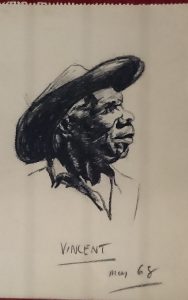38 Aboriginal and Torres Strait Islander Peoples Land Rights Movements by Emily Franken
Investigating the Wave Hill walk-off

Vincent Lingiari, 1968 by Peter Ellis, Wikimedia Commons, (CC BY-SA 4.0)
| Curriculum context | VCE Modern History Unit 2: The Changing World Order, Area of Study 2: Challenge and Change (VCAA, 2020) |
| Historical context | Aboriginal and Torres Strait Islander peoples’ land right movements |
| Historical thinking concepts | Using historical sources as evidence
Ask and use historical questions |
| Learning intentions |
Students will be able to understand Aboriginal and Torres Strait Islander Peoples’ motivations/perspectives behind the 1968 Wave Hill walk-off.
Students will analyse and evaluate primary evidence regarding the land rights movement. |
Activity
Before starting activities, we will watch The Land Owns Us with Bob Randall. This is to show the importance that Aboriginal and Torres Strait Islander Peoples feel about being connected to their Country. Follow with a class discussion on appropriate terminology.
In this activity you will analyse and investigate a primary source that is directly related to the Wave Hill walk-off. Students will need to answer literal, inferential, and evaluative questions. After these questions have been answered you need to pair up with someone who evaluated the opposite resource to you and discuss answers.
After this, you must then create 1 literal question, 1 inferential question, and 1 evaluative question on a primary source you have found that relates to an Aboriginal and Torres Strait Islander Peoples land rights movement. Students are encouraged to find a source that relates to a different movement (Tent Embassy, Handing back Uluru). Sources can be a photograph, newspaper article, video etc.
Resource 1 – Gough Whitlam pour soil into the hands of Vincent Lingiari
Literal questions:
- What is happening in the image? Describe what you see
- Who is pictured within the image? Are they important people?
Inferential questions:
- Describe the symbolism of Whitlam pouring soil into Lingiari’s hand
- What do you think the papers that Lingiari is holding entail? Describe what might be stated on them
- What does this picture celebrate for Aboriginal and Torres Strait Islander peoples’?
Evaluative questions:
- Considering where this source was published, do you think it presents exaggerated information? Why/why not?
- What is your initial evaluation of this event in relation to the struggle of Aboriginal and Torres Strait Islander peoples’ regarding land rights?
Resource 2 – 1968 ‘Land Rights For Aborigines’ pamphlet
Literal questions:
- What was the purpose of this pamphlet?
- Who was this pamphlet produced by?
Inferential questions:
- How do you think the producer of this pamphlet wanted their audience to respond? Are they trying to evoke an emotional response?
- Why would the pamphlet highlight that land rights of White Australians will not be affected?
- Why does the pamphlet highlight ‘Aboriginal successes’ that have already taken place? What is the significance of them?
Evaluative questions:
- Does this source show any bias to either Aboriginal and Torres Strait Islander peoples’ or white Australians at the time?
- Considering where this source was published and who produced it, is it likely that all the information presented within is accurate and reliable?
References
Global Oneness Project. (2009). The Land Owns Us. https://www.youtube.com/watch?v=w0sWIVR1hXw
National Archives of Australia. (n.d). Land rights for the First Australians – information supporting petition. https://www.naa.gov.au/students-and-teachers/learning-resources/learning-resource-themes/first-australians/rights-and-freedoms/land-rights-first-australians-information-supporting-petition
National Portrait Gallery. (n.d). Prime Minister Gough Whitlam Pours Soil Into The Hand Of Traditional Land Owner Vincent Lingiari. https://www.portrait.gov.au/portraits/2001.8/prime-minister-gough-whitlam-pours-soil-into-the-hand-of-traditional-land-owner-vincent
2. Analysing song lyrics

Kev Carmody performing at Pig City Concert Brisbane July 2007 by Reina Irmer, State Library of Queensland (CC BY 4.0)
| Curriculum context | VCE Modern History Unit 2: The Changing World Order, Area of Study 2: Challenge and Change
|
| Historical context | Aboriginal and Torres Strait Islander peoples’ land rights movements |
| Historical thinking concepts | Explore historical perspectives
Identify continuity and change |
| Learning intentions |
Students will be able to develop and construct a timeline representing movements related to Aboriginal and Torres Strait Islander peoples’ land rights.
Students will progress their historical skills judging the significance and reliability of events/sources |
Activity
Paul Kelly and Kev Carmody’s song ‘From Little Things Big Things Grow’ (Kelly & Carmody, 1993) communicates the outcome and the success of the Wave Hill walk-off that took place in 1966. The lyrics highlight the Gurindji Peoples’ perspectives towards their land rights. Together as a class we will unpack the lyrics within the song to highlight Aboriginal and Torres Strait Islander peoples’ perspective regarding their rights to their land.
Questions
- The lyrics “Gurindji were working for nothing but rations” and “Gurindji decided they must make a stand” who is ‘Gurindji’ referring to?
- When offered to have their wages doubled why do you think Vincent’s response was “Uh-uh we’re not talking about wages, We’re sitting right here ’til we get our land”. What does this suggest about Gurindji Peoples’ perspective about their land and Country?
- What do you think the lyric “If we fall, others are rising” means? What does it show about Aboriginal and Torres Strait Islander peoples’ perspective and hope for their future?
Timeline
After completing the questions you will collaboratively create a timeline using websites such as Canva or Venngage. The teacher will designate groups a particular time period to look into. Once all groups have finished creating a timeline for their time period, they will be merged together to create one whole timeline the class has collectively created. After the whole timeline is created, groups are to present their findings to the class.
Creating a timeline that specifically includes successes relating to laws and policies regarding Aboriginal and Torres Strait Islander peoples’ land rights will you to recognise what has changed for Aboriginal and Torres Strait Islander peoples’ and what has remained the same.
Timelines should have examples of the following:
- Key movements/events
- Legislation, policies, and laws implemented (e.g. Native Title Act)
- Key groups/significant figures
When adding an event to your timeline include these key features:
- Date
- Name of the movement/event/policy
- A brief description of the event (where did it take place? Who was involved? What did it entail?)
- Include a picture (photographs, newspaper etc.)
References
Paul Kelly [Paul Kelly]. (2018, July 21). From Little Things Big Things Grow [Video file]. https://www.youtube.com/watch?v=lN0Q_S75itE
Kelly, P., & Carmody, K. (1993). From Little Things Big Things Grow. On Bloodlines [Audio file]. Retrieved from https://open.spotify.com/album/5li5ib7EO4bdtooUhFNV6y

